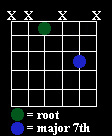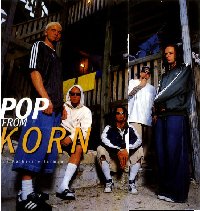
Guitar Lesson from Head And Munky:

Guitar Lesson from Head And
Munky:
........"AS SOON AS I saw an Ibanez
seven-string guitar, I just had to have one," says James "Munky"
Shaffer. "I knew having that extra low string would open up a shitload
of new sonic possibilities." That thought occurred to him five years
ago- and the dreadlocked axeman's instincts were 110 percent correct. Listen
to KoRn's latest album, Life is Peachy (Immortal/Epic), for just a few
minutes and the realization of just how versatile a seven string guitar
is will hit you in the head like a cast-iron bowling ball.
........As Shaffer and his partner in
grind, Brian "Head" Welch, quickly realized, the addition of
that seventh string quite literally expands the tonal range of the guitar.
In addition to being able to pound out those heavy-as-hell, low register
power chords at will, you still have a normal six-string instrument at
your disposal--leaving you free to explore and exploit all those upper
register notes on the high string.
........"We use all seven strings
a lot, especially on the new record," says Shaffer. "We use a
lot of open, ringing chords and a lot of notes on the high E string on
this one. We've always wanted that heavy, aggressive sound of a detuned
guitar without sounding like Carcass or those other death metal bands."
A great example of KoRn maing full use of the extended tonal range of their
seven strings is the to Life is Peachy's "Good God" which is
similar to FIGURE 1. In this riff, Shaffer and Welch literally bounce between
a palm-muted open low B string [Note: for extra oomph, KoRn tunes all seven
strings down a whole step (A D G C F A D, low to high).] to the C note
at the 20th fret on the high E string, which is four full octaves and a
semitone higher. "It's a cool riff, but it's a bitch to play,"
laughs Welch.
........Unfortunately, the majority of
people do not own seven-string gutiars. Here are several options for those
who want to play along to a KoRn track with a standard six-string guitar.
........1) Tune your guitar down a perfect fourth (low to high: B E A D F# B). This is cool tuning if you're into Morbid Angel, but for the average Joe, its probably too extreme--it will literaly transform everything you play, even James Taylor tunes, into death metal. Also, detuning this far down will require you to beef up your guitar's string guages considerably and will probably create the need for an intonation and truss rod adjustment.
........2) Leave your guitar tuned to concert pitch (A=440) and then play KoRn riffs an octave higher than they are on the CD. By doing this, you can pedal the open the A string whenever Shaffer and Welch pound on their extra string (remember, KoRn tune down a whole step, so the sounding pitch of their low B strings is actually A). FIGURE 2, a riff not unlike the intro to "I Need" (KoRn) is played in this fashion.
........3) Use drop-D tuning (low to high: D A D G B E) for added low-end girth. Check out the February, 1996 issue of Guitar School for a transcription of "Blind" [KoRn], which is arranged for six-string guitar using this tuning.
........4) Tune each string down a whole-step (low to high: D G C F A C) and then just deal with the fact that you don't have that extra low string and adapt accordingly, using inverted power chords and/or playing the very lowest notes an octave higher when necessary. The April, 1996 issue of Guitar World features a transcription of "Shoots and Ladders" [KoRn] which is adapted for six-string guitars in this tuning.
............For the sake of simplicity and also to minimize your detuning dilemma, this lesson is based around tuning option #4 (detuning all six strings one whole step). Also, to ensure that we get the most out of our guest teachers, we're going to zone in on a few of KoRn's sickest sounding secrets--their brilliant and bizarre use of dissonant intervals (two-note combinations).
EVIL TRIPLETS
........The three intervals that are
most disturbing to the human ear are the minor second (two notes a half-step
apart), the tritone (three whole-steps apart) and the major seventh (an
octave minus a half-step). As expected, KoRn make frequent use of all three.
"We love stuff that sounds weird and eerie," says Shaffer. Let's
kick-off with the minor second.
........FIGURE 3 is a fretboard diagram
of a minor second diad (two notes played together) on the G and B strings.
Played with distortion, this pairing can sound quite jarring. FIGURE 4
shows this interval used to excellent effect during the verse of "Daddy,"
from KoRn. "We use the same idea in the chorus, but the open-string
notes ringing against fretted ones," explains Welch, playing FIGURE
5.
........Shaffer and Welch also emplo the
minor second diad illustrated in FIGURE 3 to create the robotic-sounding
intro to "No Place to Hide" from Life is Peachy. "I go right
here," states Welch performing FIGURE 6, "while Munky plays the
exact same thing but lower on the nechk." [FIGURE 7] As disturbingly
cool as the resulting dual part is, Shaffer and Welch don't linger on it
for long. After a few bars, they take the rhythmic idead they've introduced
and start tearing it up using good old regular root/fifth power chords
as shown arranged for a six-string guitar in FIGURE 8. Then, after doing
this in unison for a while, they fill in the holes in the riff to "make
it sound like a motorcycle." [FIGURE 9] To beef up this change even
further, a phase pedal is used and Welch plays the part an octave higher
than Shaffer as illustrated in FIGURE 10.
........"We call this the 'Mr. Bungle
Chord,'" Shaffer explains as he fingers the moveable tritone diad
in FIGURE 11. "They always do that weird sort of stuff, so we named
the chord after them. To make it sound bigger, you can double up the low
note an octave higher," he adds, demonstrating FIGURE 12. If you glance
back at FIGURE 2 you'll notice that we've already seen this idea in action.
FIGURE 13 is the intro to Life is Peachy's "K@#%!" As you can
see, it is totally comprised of "Mr. Bungle chords." As was the
case with their "No Place to Hide" intro, Shaffer and Welch don't
linger with this weirdness for too long. Once again, after a few repeats,
they head down low and revert to using power chords to hammer the riff
home. [FIGURE 14]
........FIGURE 15 shows the chord shape
Shaffer strums at the very start of the band's breakthrough track, "Blind."
This is basicaly an E tritone chord (E Bb E) on the D, G and B strings
[FIGURE 16] with a low B (the fifth of E) thrown in at the 2nd fret on
the A string. This added note adds even more dissonance to proceedings
as it definitely jars with the Bb note at the 3rd fret of the G string.
(Keep in mind that KoRn detune their guitars a whole step, so everything
sounds a whole step lower than normal.) If we isolate these two notes [FIGURE
17], we find that the interval they create is a half-step short of an octave,
namely a major seventh--the third of our evil trio of intervals.
THE SEVENTH DEADLY SIN
........"This is our latest,
out-of-tune sounding shape," Welch explains while playing the moveable
minor seventh diad shown in FIGURE 17. "We use it in the song 'Twist'
[Life is Peachy]." FIGURE 18 is a six-string adaption of this riff.
When performaing this particular motif, Shaffer and Welch use the moveable
shape depicted in FIGURE 17. Those of you with six-string guitars don't
have that extra low B string to pedal on, so it is necessary to play the
note an octave higher at the 7th fret on the low E string. So, in order
to minimize free-hand movement we've used the major seventh shape shown
in FIGURE 19.
........To conclude our KoRn lesson, we
asked the guest guitar tutors if they had any advice they'd like to pass
on. They did. "We're not real technical guitarists, we just play what
sounds good to us." says Shaffer. "Everything Brian and I play
comes from our hearts. And if you always play from your hear, you'll never
make a mistake."
........"Someone might tell you that
a particular note in a solo or riff is wrong," adds Welch. "But
if it feels good to you, then it's okay. As long as you love what you're
playing, nothing is wrong."
Figure 1
7 string down one hole step (low to high: A D G C F A D)
P.M.-----| P.M.-----|
||-------20----------20--------||-------20----------20-------||
||-----------------------------||----------------------------||
||-----------------------------||----------------------------||
||-----------------------------||----------------------------||
||-----------------------------||----------------------------||
||--1-0------0-0--0------1--0--||--1-0------0-0--0------1-0--||
Figure 2
6 string in standard tuning
||-------------||--------------------||
||-------------||--15-------15-------||
||--8----8-----||--14-------14-------||
||----0-----0--||--13--0----13---0---||
||-------------||--------------------||
||-------------||--------------------||
Figure 3
Moveable minor 2nd diad
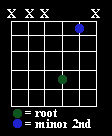
Figure 4
* Tune down one whole step (low to high: D G C F A D)
let ring...........................................
||-------------------||------------------||
||-------13----------||------12------12--||
||---16--------------||--15------15------||
||-------------------||------------------||
||-------------------||------------------||
||-------------------||------------------||
* All Pitches sound one whole-step lower than written
Figure 5
* Tune down one whole-step (low to high: D G C F A D)
let ring................
||------------------------||------------------------|-------------------||
||------------------------||------------------------|-------------------||
||------------0-----0-----||------------------------|--------0-----0----||
||---------------3-----3--||------------0------0----|-----------4-----4-||
||---5---4----------------||--4--5--3-------4-----4-|--4--3-------------||
||---3---4----------------||--4--5--3---------------|--4--3-------------||
* 7 String guitar arranged for 6 string
Figure 6
* Tune down one whole-step (low to high: D G C F A D)
||-------------------------------------------------------------||
||--14/-/15---15/-/16---14/-/15---15/-/16---14/-/15---15/-/16--||
||--17/-/18---18/-/19---17/-/18---18/-/19---17/-/18---18/-/18--||
||-------------------------------------------------------------||
||-------------------------------------------------------------||
||-------------------------------------------------------------||
* All pitches sound one whole-step lower than written.
Figure 7
* Tune down one whole-step (low to high: D G C F A D)
||-------------------------------------------------------------||
||---9/-/10---10/-/11----9/-/10---10/-/11----9/-/10---10/-/11--||
||--12/-/13---13/-/14---12/-/13---13/-/14---12/-/13---13/-/14--||
||-------------------------------------------------------------||
||-------------------------------------------------------------||
||-------------------------------------------------------------||
* All pitches sound one whole-step lower than written.
Figure 8
* Tune down one whole-step (low to high: D G C F A D)
||-------------------------------------------------||
||-------------------------------------------------||
||-------------------------------------------------||
||-------------------------------------------------||
||-------------------------------------------------||
||--3/-/4---4/-/5---5/-/6---6/-/7---6/-/7---7/-/8--||
* All pitches sound one whole-step lower than written.
7-string guitar (low to high: A D G C F A D) arranged for 6 string guitar.
Figure 9
* Tune down one whole-step (low to high: D G C F A D)
||-------------------------------------------------------||
||-------------------------------------------------------||
||-------------------------------------------------------||
||-------------------------------------------------------||
||--3/4---4---4/5---5---5/6---6---6/7---7---6/7----7/8---||
||--3/4---4---4/5---5---5/6---6---6/7---7---6/7----7/8---||
* All pitches sound one whole-step lower than written.
7-string guitar (low to high: A D G C F A D) arranged for 6 string guitar.
Figure 10
* Tune down one whole-step (low to high: D G C F A D)
||-------------------------------------------------------||
||-------------------------------------------------------||
||--5/6---6---6/7---7----/8---8---8/9---9---8/9----9/10--||
||--5/6---6---6/7---7---7/8---8---8/9---9---8/9----9/10--||
||--3/4---4---4/5---5---5/6---6---6/7---7---6/7----7/8---||
||-------------------------------------------------------||
* All pitches sound one whole-step lower than written.
7-string guitar (low to high: A D G C F A D) arranged for 6 string guitar.
FIGURE 11
"Mr. Bungle Chord"
(two-note version)
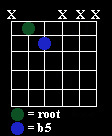 FIGURE 12
"Mr. Bungle Chord"
(three-note version)
FIGURE 12
"Mr. Bungle Chord"
(three-note version)
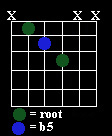 Figure 13
* Tune down one whole-step (low to high: D G C F A D)
||------------------------------------||
||------------------------------------||
||------------------------------------||
||------------------------------------||
||--11/10--9---8---8---8/9\8---8---8--||
||--10/9---8---7---7---7/8\7---7---7--||
* All pitches sound one whole-step lower than written.
7-string guitar (low to high: A D G C F A D) arranged for 6 string guitar.
Figure 14
* Tune down one whole-step (low to high: D G C F A D)
||------------------------------------||
||------------------------------------||
||------------------------------------||
||------------------------------------||
||----5\4---3---2---2---2/3\2--2---2--||
||----5\4---3---2---2---2/3\2--2---2--||
* All pitches sound one whole-step lower than written.
7-string guitar (low to high: A D G C F A D) arranged for 6 string guitar.
Figure 15
"Blind" into chord
Figure 13
* Tune down one whole-step (low to high: D G C F A D)
||------------------------------------||
||------------------------------------||
||------------------------------------||
||------------------------------------||
||--11/10--9---8---8---8/9\8---8---8--||
||--10/9---8---7---7---7/8\7---7---7--||
* All pitches sound one whole-step lower than written.
7-string guitar (low to high: A D G C F A D) arranged for 6 string guitar.
Figure 14
* Tune down one whole-step (low to high: D G C F A D)
||------------------------------------||
||------------------------------------||
||------------------------------------||
||------------------------------------||
||----5\4---3---2---2---2/3\2--2---2--||
||----5\4---3---2---2---2/3\2--2---2--||
* All pitches sound one whole-step lower than written.
7-string guitar (low to high: A D G C F A D) arranged for 6 string guitar.
Figure 15
"Blind" into chord
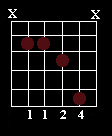 FIGURE 16
E tritone chord
FIGURE 16
E tritone chord
 FIGURE 17
moveable major 7th diad
FIGURE 17
moveable major 7th diad
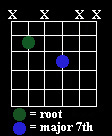 Figure 18
* Tune down one whole-step (low to high: D G C F A D)
P.M......| P.M.......|
||-------------------------------------------------------||
||-----------11/12/13-------------12\11\10---------------||
||------------9/11/11-------------10\-9\-8---------------||
||-------------------------------------------------------||
||-------------------------------------------------------||
||--7--7--7-------------7--7--7--------------------------||
* All pitches sound one whole-step lower than written.
FIGURE 19
moveable major 7th diad
Figure 18
* Tune down one whole-step (low to high: D G C F A D)
P.M......| P.M.......|
||-------------------------------------------------------||
||-----------11/12/13-------------12\11\10---------------||
||------------9/11/11-------------10\-9\-8---------------||
||-------------------------------------------------------||
||-------------------------------------------------------||
||--7--7--7-------------7--7--7--------------------------||
* All pitches sound one whole-step lower than written.
FIGURE 19
moveable major 7th diad
